 myCSUSM
myCSUSMCheckist for Zoom Webinar
Zoom Webinars
Meetings are designed to be a collaborative event where all parties can share, whereas webinars are designed so that the host and designated panelists can share and view-only attendees can watch the presentation. Zoom meetings can host up to 500 participants and allow participants video or profile pictures to be displayed. Webinars are for up to 3,000 participants with options to extend more using YouTube Live.
If you are hosting a large event, or don't want participant video or profile pictures displayed, contact us at mps@csusm.edu to discuss the Zoom webinar option and get a webinar license. Not sure if you need a Zoom meeting or Zoom webinar, review the comparison chart to help you decide.
Pre-event planning decisions
- Who will be co-hosts controlling the event?
- Who will be panelists speaking during the event?
- Will there be question and answer?
- What kind of chat will be allowed? The chat settings in a webinar are:
- no chat
- chat to panelist
- chat to panelist and attendees
- Who will moderate chat and Q&A? Make sure they practice ahead of time so they know how to moderate.
- Will registration be required? This allows collection of information about who is attending that can be useful for post-event follow-up. Decide what extra questions you would like registrants to answer. If using registration for a public event, it is not recommended to use auto approve as it will automatically send the meeting info to the recipient.
- Will the event be recorded? If so, how and with whom will it be shared after the event?
- How will the link to the event be shared? This is both a practical and security consideration, since we want to make sure our desired audience has easy access, but access is restricted as much as possible to the desired audience to prevent unwanted interference.
- Begin gathering all necessary presentation materials, including PowerPoint or other presentations, websites, videos, etc.
Event Scheduling
- https://support.zoom.us/hc/en-us/articles/204619915-Scheduling-a-Webinar-with-Registration
- Inform all necessary parties:
- Send webinar link to co-hosts and panelists.
- Share meeting link with promotional partners, e.g. campus communications, related departments, etc.
- Place meeting invite on relevant websites and social media. You want to reach the intended audience, but sharing meeting links publicly can have risks of unwanted participants. Share judiciously. Do not publish a password publicly if using a password.
Pre-Event Setup and Testing
- One week prior to the event
- Share event agenda with all co-hosts and panelists.
- Convene the co-hosts and panelists and do a quick run thru of the basic event structure. Test screen shares and presentation materials.
- Have all co-hosts and panelists update Zoom on the machine they will use in the webinar.
- Examine registration responses for interesting question responses.
- 30 minutes prior to the event start - have all co-hosts sign into the meeting and verify:
- That the person controlling the Zoom session is listed as Host in the Participants window. This is generally the meeting organizer.
- That all co-hosts are listed as such in the Participants window. If they are not, make them co-hosts.
- That all panelists are listed as such in the Participants window.
- That all necessary presentation materials are present and ready, including: powerpoint docs, websites, and videos.
- Five minutes before event start:
- Start recording.
During the Event
- Follow the meeting agenda.
- In case of disruption by unwanted participants, refer to Appendix A: Security Things You Can Do During A Meeting.
- Moderator role
- Monitor chat and Q&A a refer questions/comments to panel as necessary.
After the Event
- Meeting to discuss things that did or did not go well for reference in doing future webinars.
- Export registration list in spreadsheet format and process as necessary for follow-up.
- Share meeting recording with approved list. See Appendix B: Sharing Recordings.
Appendix A: Security Things You Can Do During A Meeting
While the best scenario is to keep disruptive persons out of your meeting to begin with, if your meeting is being disrupted, there are things you can do to minimize the disruption.
- Mute individual
A participant could be saying something or simply making noise. You can Mute the individual person. The Mute button next to each person’s name in the Participants window.
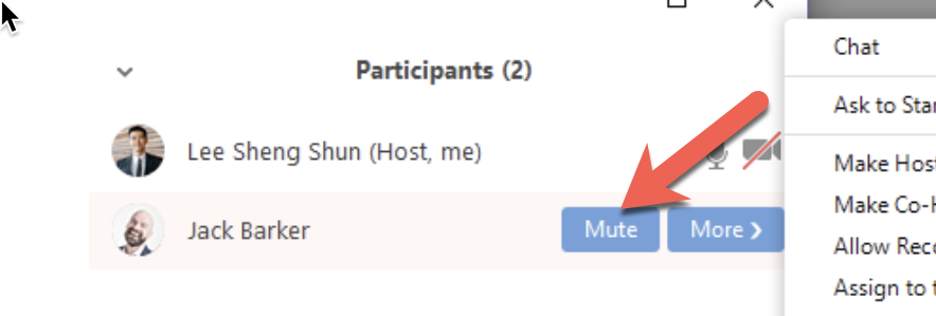
- Mute everyone
Mute All – if you’re not sure who’s making the noise. The Mute All button at the bottom of the Participants window.
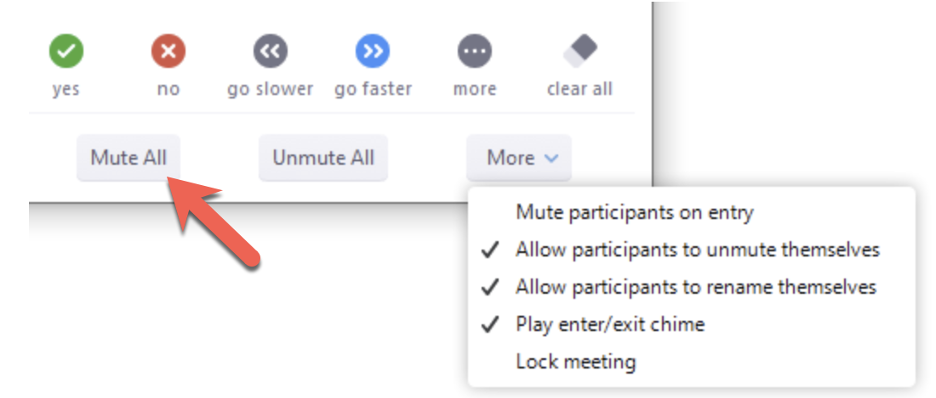
- Prevent participants from unmuting themselves
Remove participants’ ability to unmute themselves. The More menu at the bottom of the Participants window. At this point you, as Host, are the only person that can unmute someone.
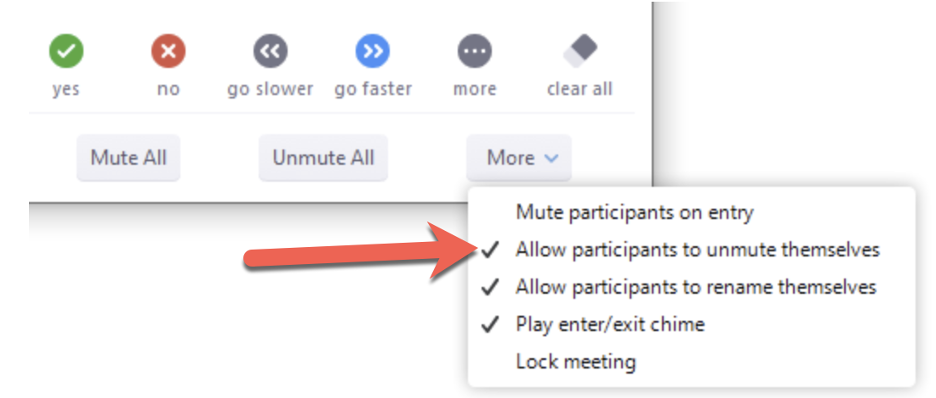
- Turn off participant's video
A participant could have something offensive in their webcam video or in their virtual background. Mute the video of a participant. The small camera icon next to each person’s name that allows you to turn their camera off.
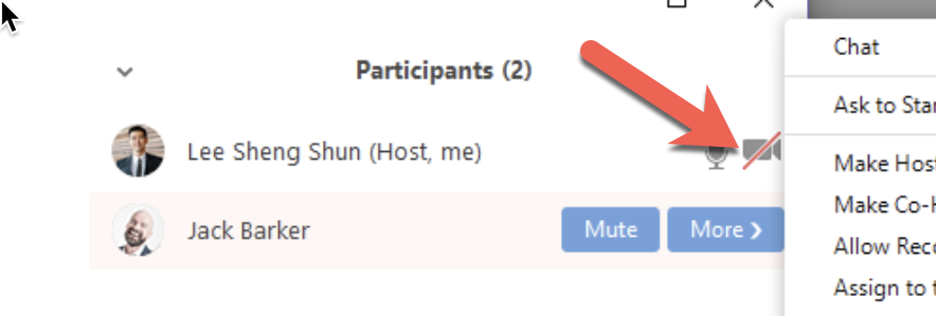
NOTE: Participants can turn their video back on. You cannot prevent this.
- Screen share
One of Zoom’s basic capabilities is screen sharing, but someone may attempt to share something objectionable. You can stop anyone from sharing their screen unless you allow it.
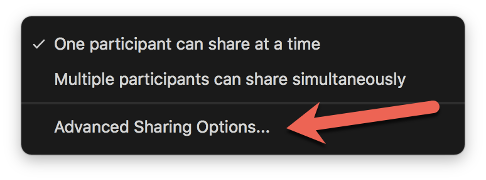
Advanced Sharing Options under the Screen Sharing menu at the bottom center.
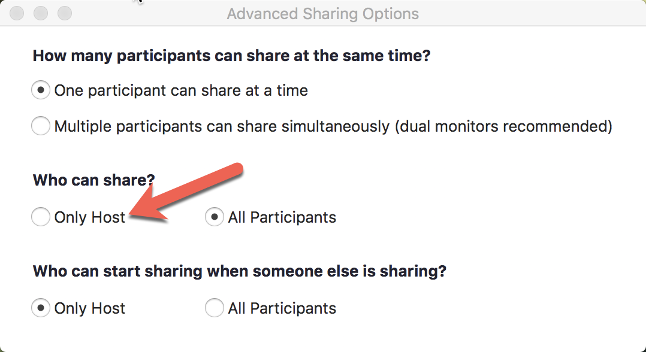
With this selected, only you – the host – can screen share.
- Prevent screen share during a meeting
This can also be done in the Security menu, available at the bottom of the screen.
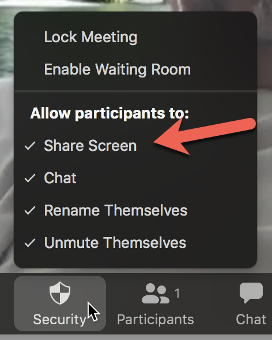
- Stop screen share during a meeting
Stop a screen share already in progress. While someone is sharing, this button is at the top of the screen. Click it to stop the share.

- Remove disruptive participant in meeting
You can remove a disruptive participant out of a meeting. Pop up the More menu next to a person’s name in the Participants window and choose Remove.
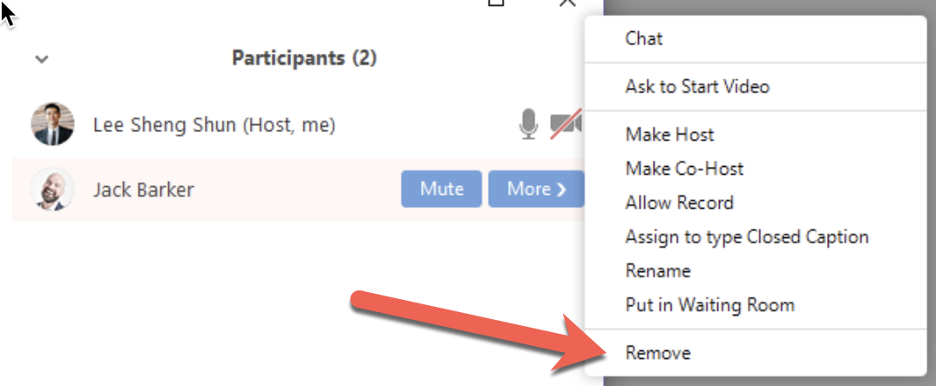
- Prevent removed person from reentering
This tutorial shows you how to prevent people you have removed from meetings from reentering: https://support.zoom.us/hc/en-us/articles/36002185137
Sharing Zoom Recordings
- Managing Cloud Recordings
- Upload recordings to YouTube
If your recordings are saved on your computer, or you downloaded to edit, you need to upload them before you can share them with students. You can upload them to YouTube (unlisted) or Microsoft Stream.
YouTube: https://support.zoom.us/hc/en-us/articles/202291078-Upload-Local-Recording-to-the-Cloud
- Video captioning
Request captions for your videos: https://www.csusm.edu/ats/media/videoproduction/caption/captionrequest.html
Appendix B: Sharing Zoom Recordings
- Managing Cloud Recordings
- Upload recordings to YouTube
If your recordings are saved on your computer, or you downloaded to edit, you need to upload them before you can share them with students. You can upload them to YouTube (unlisted) or Microsoft Stream.
YouTube: https://support.zoom.us/hc/en-us/articles/202291078-Upload-Local-Recording-to-the-Cloud
- Video captioning
Request captions for your videos: https://www.csusm.edu/ats/media/videoproduction/caption/captionrequest.html






